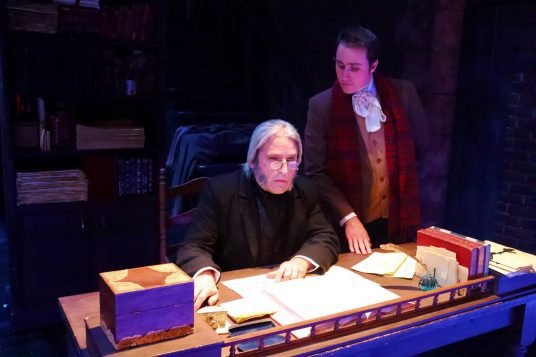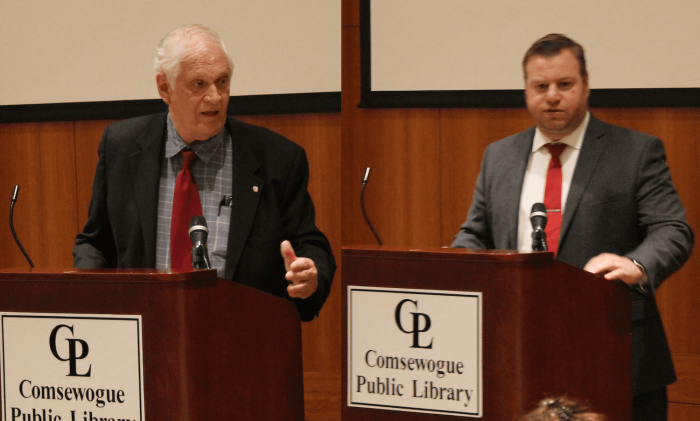By Heidi Sutton
“Marley was dead: to begin with. There is no doubt whatever about that.” And so begins one of the most popular, most-adapted and most relevant holiday tales ever written, Charles Dickens’ novella, A Christmas Carol. Published on Dec. 19, 1843, the initial print run of 6,000 copies sold out by Christmas Eve. More than 178 years later, it lives on as a story of redemption and hope and serves as a reminder to keep the spirit of Christmas in our hearts all year round.
In the book’s foreword, Dickens writes:
I have endeavoured in this Ghostly little book, to raise the Ghost of an Idea, which shall not put my readers out of humour with themselves, with each other, with the season, or with me. May it haunt their houses pleasantly, and no one wish to lay it.
Now the pages of the Dickensian story come to life once again as Theatre Three in Port Jefferson presents its 38th annual production of A Christmas Carol. The curtain went up this past Saturday to a full house.
While preparations are still underway to transform the seaport village back to the Victorian era for its 26th annual Charles Dickens Festival on Dec 3 and 4, Theatre Three is already dressed head to toe for the holidays and carolers entertain theatergoers before the show, setting the tone for what is to come.
Adapted for the stage by Executive Artistic Director Jeffrey Sanzel, A Christmas Carol tells the tale of Ebenezer Scrooge (played by Sanzel), a successful business man who has chosen money over everything else and has become bitter, lonely and stingy over the years, especially around the holidays. “I have devoted my life to the cultivation of business,” he explains.
We first meet the miserly curmudgeon on Christmas Eve, exactly seven years after the death of his business partner Jacob Marley (Stephen T. Wangner). Caught in a particulary bad mood, we witness him chase carolers from his office, turn away the needy and a pair of charity workers. He snaps at his underappreciated and underpaid clerk Bob Cratchit (Douglas J. Quattrock) and his chipper nephew Fred Halliwell (Sean Amato) the sole child of Scrooge’s deceased sister, Fan, who has dropped by to invite him for dinner. “Keep Christmas in your own way and I will keep it in mine,” he warns his nephew before kicking him out.
That evening Scrooge is visited by Marley’s tormented ghost who offers him one last chance at redemption. Draped in the chains he has forged in life, Marley tells Scrooge he will be visited by three spirits — the ghosts of Christmas past, present and future.
The Ghost of Christmas Past (Danielle Pafundi) appears soon after, all aglow in a white dress, and takes Scrooge to Wellington House, the boarding school he attended as a young boy alone; we meet his adored sister Fan and his apprenticeship at Fezziwig’s (played by Scott Hofer), where the audience is introduced to Scrooge’s one and only love, Belle. This is also where he meets Marley for the first time and where his choices take him down a dark path.
The Ghost of Christmas Present (Scott Hofer) takes Scrooge to meet Bob Cratchit’s family where he learns about Tiny Tim’s failing health and to a dinner party hosted by his nephew where guests play a fun game of Yes or No.
In one of the most anticipated and frightful scenes, a towering Ghost of Christmas Future (operated by Sean Amato) shows Scrooge the shadows of what is yet to come, including at trip to the cemetery to see his headstone, and how the people in his life are affected after his death, including a disturbing scene where Scrooge’s housekeeper Mrs. Dilber (Ginger Dalton) attempts to profit from his demise. It is just what Scrooge needs to shake him to the core. In the end, he learns that “life is not about facts and figures. It’s about joy and family and Christmas.”
Directed by Sanzel, the entire production is flawless and the talented cast (playing multiple roles) is excellent. As Scrooge, Sanzel is at his finest in a role he has played almost 1500 times. This is most evident when the Ghost of Christmas Past takes his character to one of Fezziwig’s famous holiday parties. While otherwise slightly hunched over with a slow walk, Sanzel suddenly jumps into the role of a younger Scrooge and takes part in a Wassail dance (choreographed by Sari Feldman) with boundless energy.
Although in its 38th year, the show is always evolving, remaining fresh and exciting while maintaining its timelessness and important message. The Victorian set, costumes and creative lighting tie it all together to create a magical evening at the theater.
Get your ticket to see this wonderful production “before you dot another ‘i'” and make it part of your holiday traditions. It will make your heart full.
Stay after the show for a photo keepsake with Scrooge. The $5 fee goes to support the theater’s scholarship fund.
The Cast: Sean Amato, Ava Andrejko, Ginger Dalton, Ellie Dunn, Alexa Eichinger, Samantha Fierro, Griffin Fleming, Julie Friedman, Skye Greenberg, Kathleen Han, Scott Hofer, Patrick Hutchinson, Linda May, Brooke Morrison, Danielle Pafundi, Douglas J. Quattrock, Michaela Reis, Dylan Paige Rumble, Vivian Leigh Rumble, Jeffrey Sanzel, Jennifer Salvia, Steven Uihlein, Addyson Urso, Hannah Waller, Stephen T. Wangner and Cassidy Worrell.
Theatre Three, 412 Main St., Port Jefferson presents Charles Dicken’s A Christmas Carol through Dec. 30. Tickets are $20 per person in November, and $35 adults, $28 seniors and students, and $20 children ages 5 and up in December. To order, call 631-928-9100 or visit www.theatrethree.com.
































